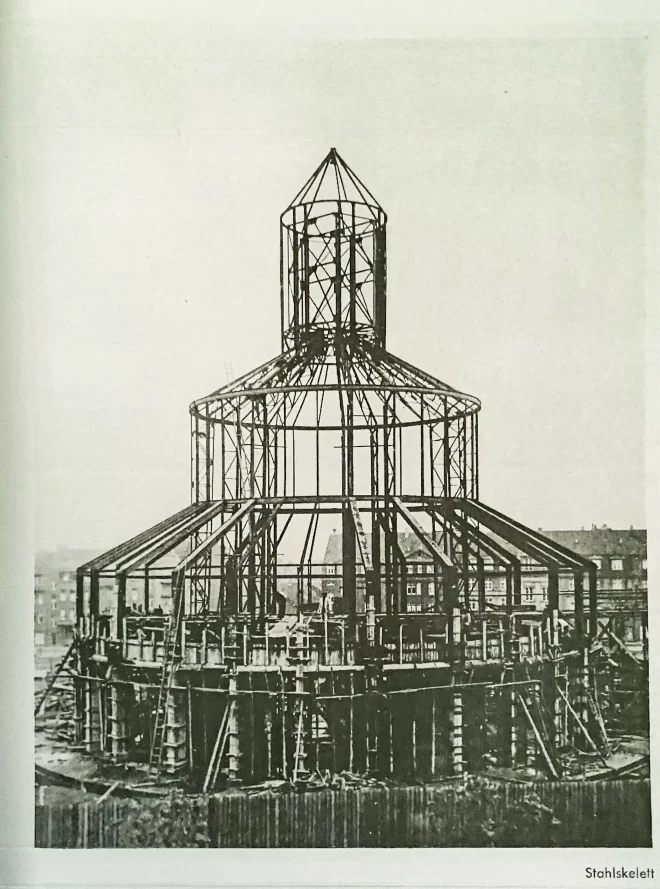1929 – 1930
Architect: Otto Bartning
Steubenstrasse 50, Essen, Germany
The Protestant Church of the Resurrection (Auferstehungskirche) in Essen’s southeastern district was built between 1929 and 1930 to plans by architect Otto Bartning. It is considered to be one of the leading examples of modern church architecture in Europe.
After a two-stage competition, Otto Bartning was commissioned to build the new church in the east of Essen. The cornerstone was laid on July 14, 1929, and the church was consecrated on June 22, 1930.
Construction took place during the Great Depression. The lowest bidder, a company from Dortmund, was not allowed to start the construction until it had established a branch office in Essen. Thus, the company was able to prove that it would create jobs for the people of Essen.
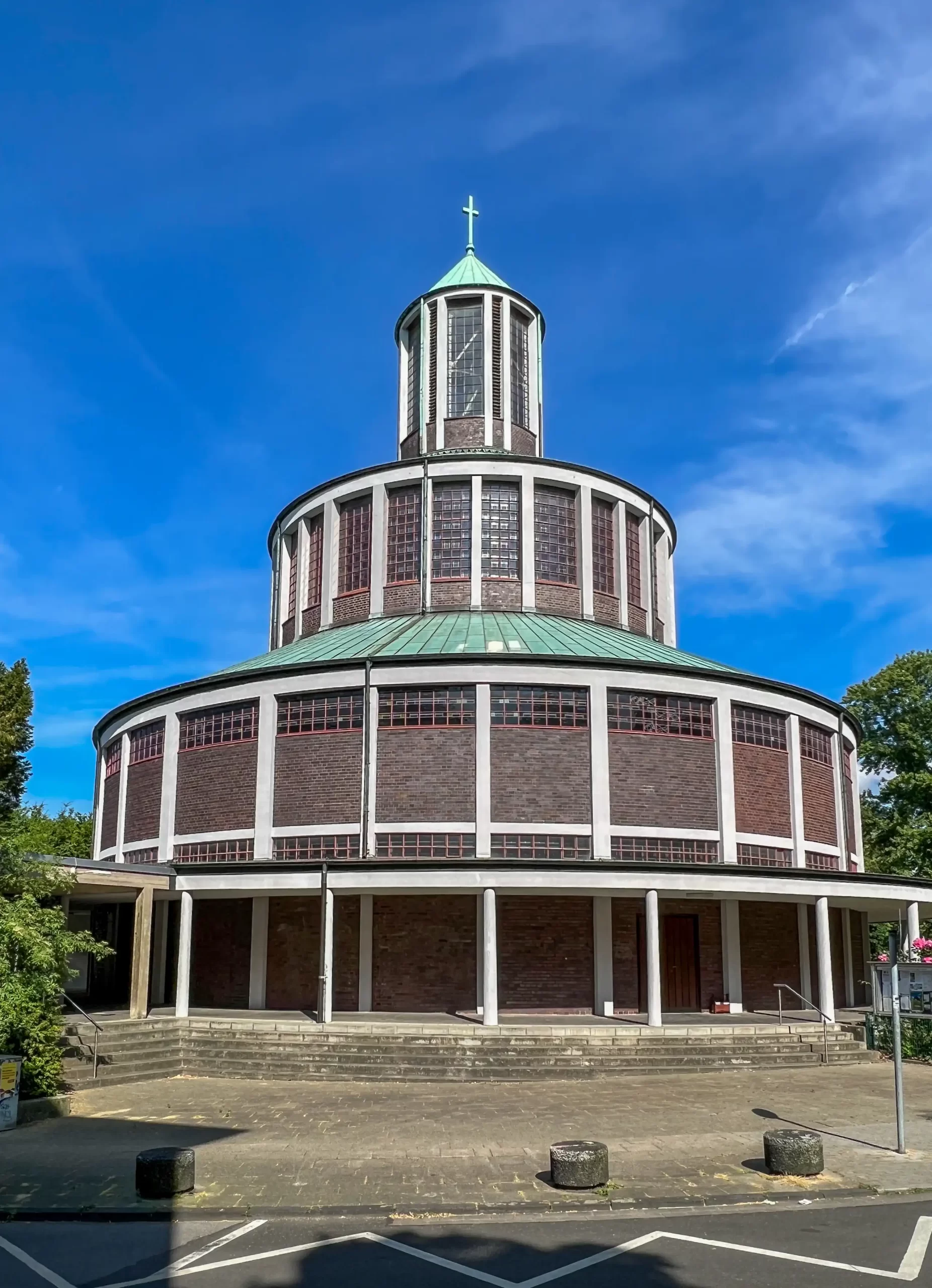
Auferstehungskirche, 1929-1930. Architect: Otto Bartning. Photo: Daniela Christmann
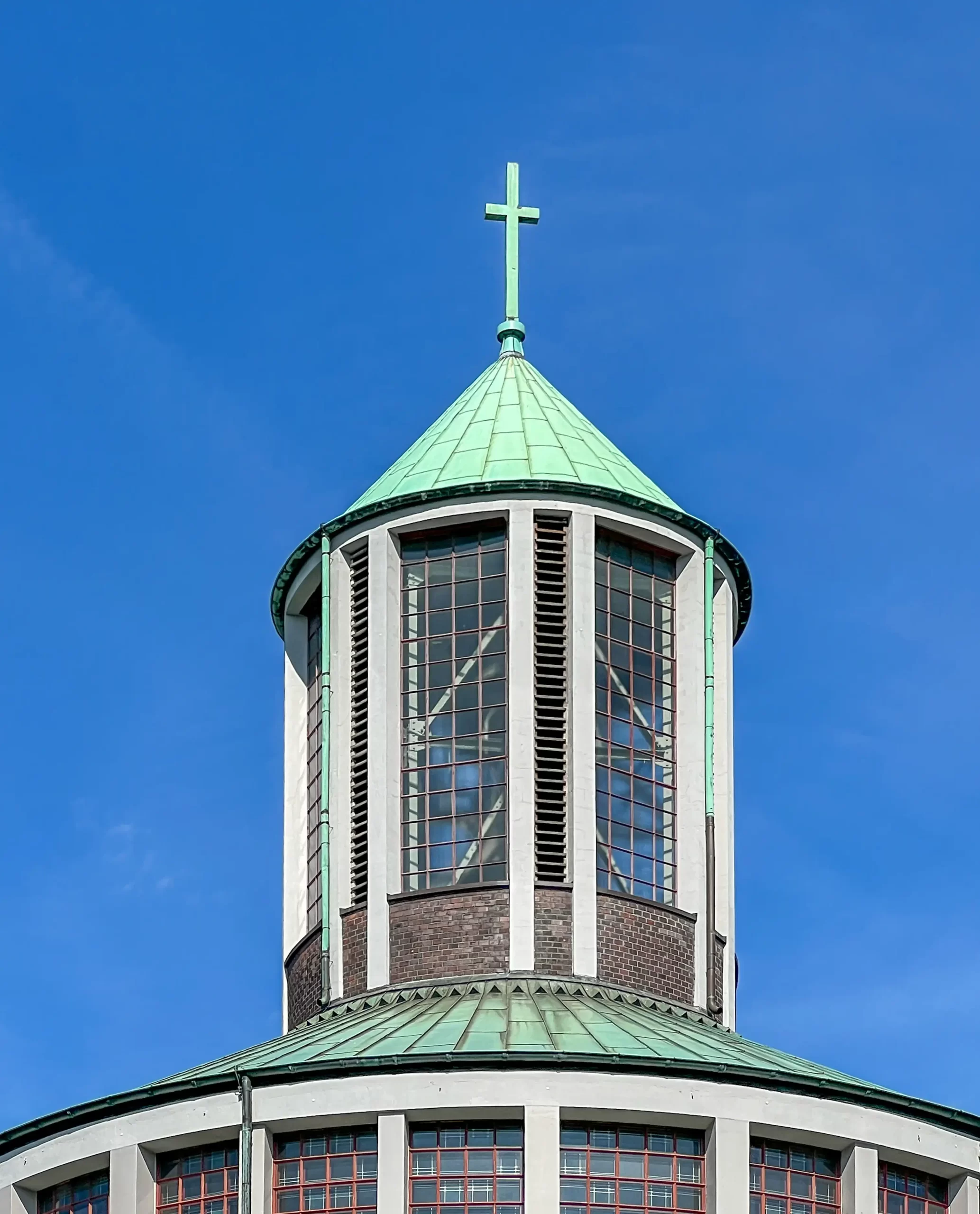
Auferstehungskirche, 1929-1930. Architect: Otto Bartning. Photo: Daniela Christmann
Sternkirche (Star Church)
From 1929 to 1930, Otto Bartning realized his idea of a round church in the Auferstehungskirche in Essen.
It is thus very close to the Sternkirche, which Bartning had designed as a model in 1922, but which was never built.
The Sternkirche was laid out in crystalline forms over a heptagonal floor plan: “The Sternkirche is a central building as the simplest expression of the Protestant congregation. The pulpit stands in the spiritual and structural center of the room, at the intersection of all lines of sight.
The pews surround the pulpit in an ascending semicircle. The altar with the cross also stands in the center of the building, but not in front of or under the pulpit, but above the pulpit, on a mountain, as it were, as the spiritual and architectural highlight of the room” (Otto Bartning).
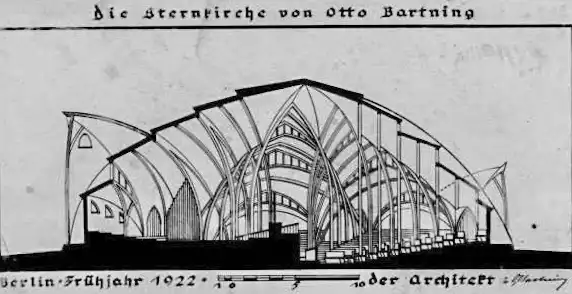
Sternkirche, 1922. Design: Otto Bartning
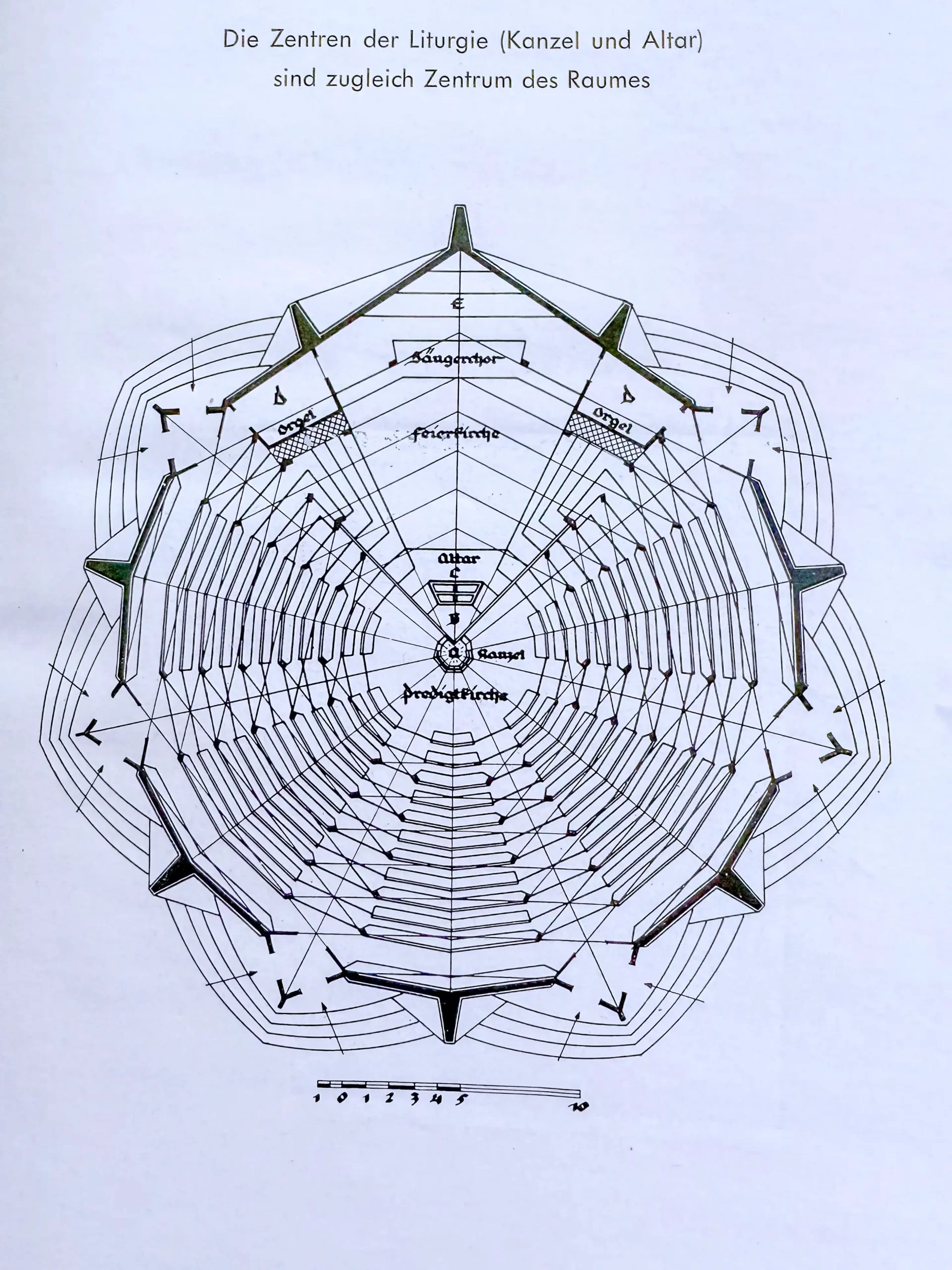
Sternkirche, 1922. Design: Otto Bartning. Floor plan
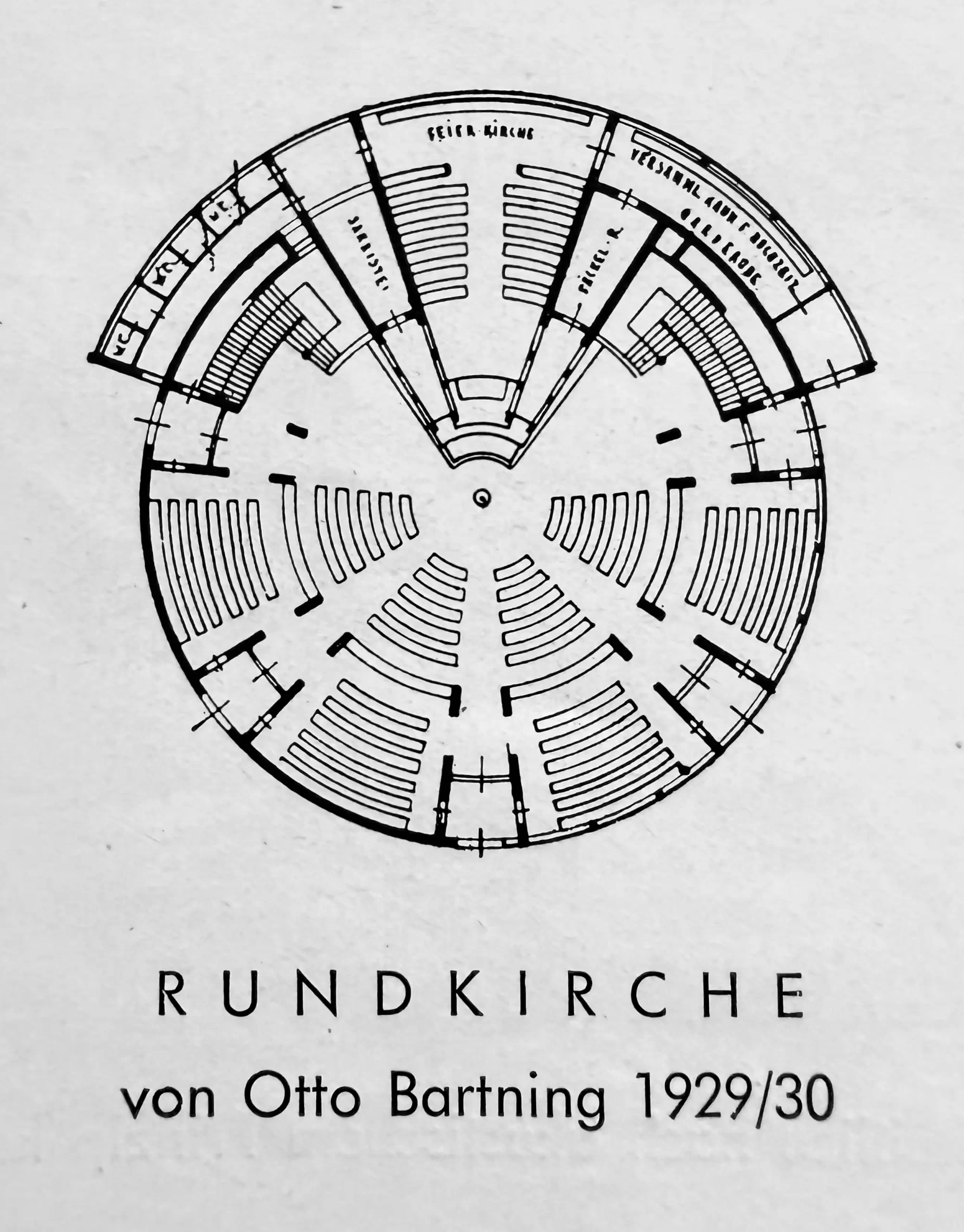
Auferstehungskirche, 1929-1930. Architect: Otto Bartning. Floor plan
Exterior of the Auferstehungskirche
The Church of the Resurrection in Essen is a simple central building on a circular ground plan with a diameter and height of about 30 meters.
The church is a steel skeleton structure with concrete fire protection cladding. The exterior walls are clad in clinker brick.
With steel, concrete and clinker, Bartning made a commitment to modernism and to the region in which the church is located. The building seats about 700 people.
The reinforced concrete skeleton construction is visible on the exterior façade. The bays are filled with red-brown clinker bricks framed by horizontal ribbon windows at the bottom.
The church building consists of three superimposed cylinders with tapering diameters. Between the second and third levels there are mono-pitched roofs, the uppermost cylinder ends with a conical roof with a cross.
The top floor is highlighted in the form of a lantern.
Another level is added on the entrance side by a flat canopy resting on round columns. The bays are filled with red-brown clinker bricks framed by horizontal bands of windows in the lower part.
The central cylinder is largely dissolved into a window zone, while the upper cylinder shows the sound louvers of the bell tower.
Directed lighting is provided by the gallery ring and the lantern.
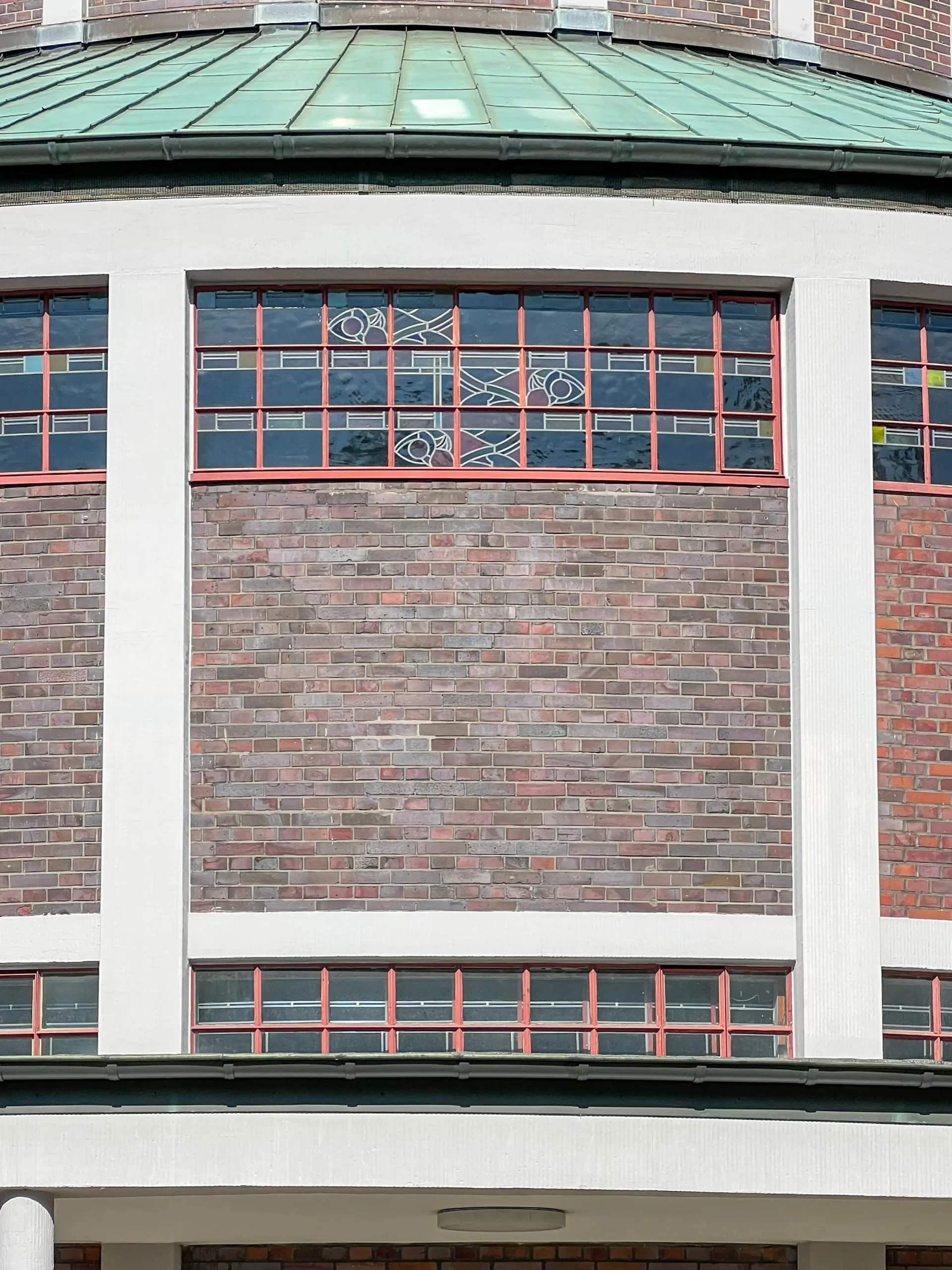
Auferstehungskirche, 1929-1930. Architect: Otto Bartning. Photo: Daniela Christmann
Interior of the Auferstehungskirche
Slender columns surround the interior in pairs and across the floors. The altar is framed by a row of columns that rises toward the center.
Behind the altar, like a cut-out segment, there is a space that can be used as a celebration church: it can be used from the altar, but it can also be covered with a curtain.
On each level, the circular shape is emphasized by surrounding bands of light from festoon lamps.
The surfaces are finished with light mica plaster and dark gray plaster, the ceiling surfaces are painted red and the radial ceiling beams are dark.
What was new and essential in this building was the relocation of the altar to the center of the church, and the demarcation and design of the rear part as a celebration church in addition to the preaching church.
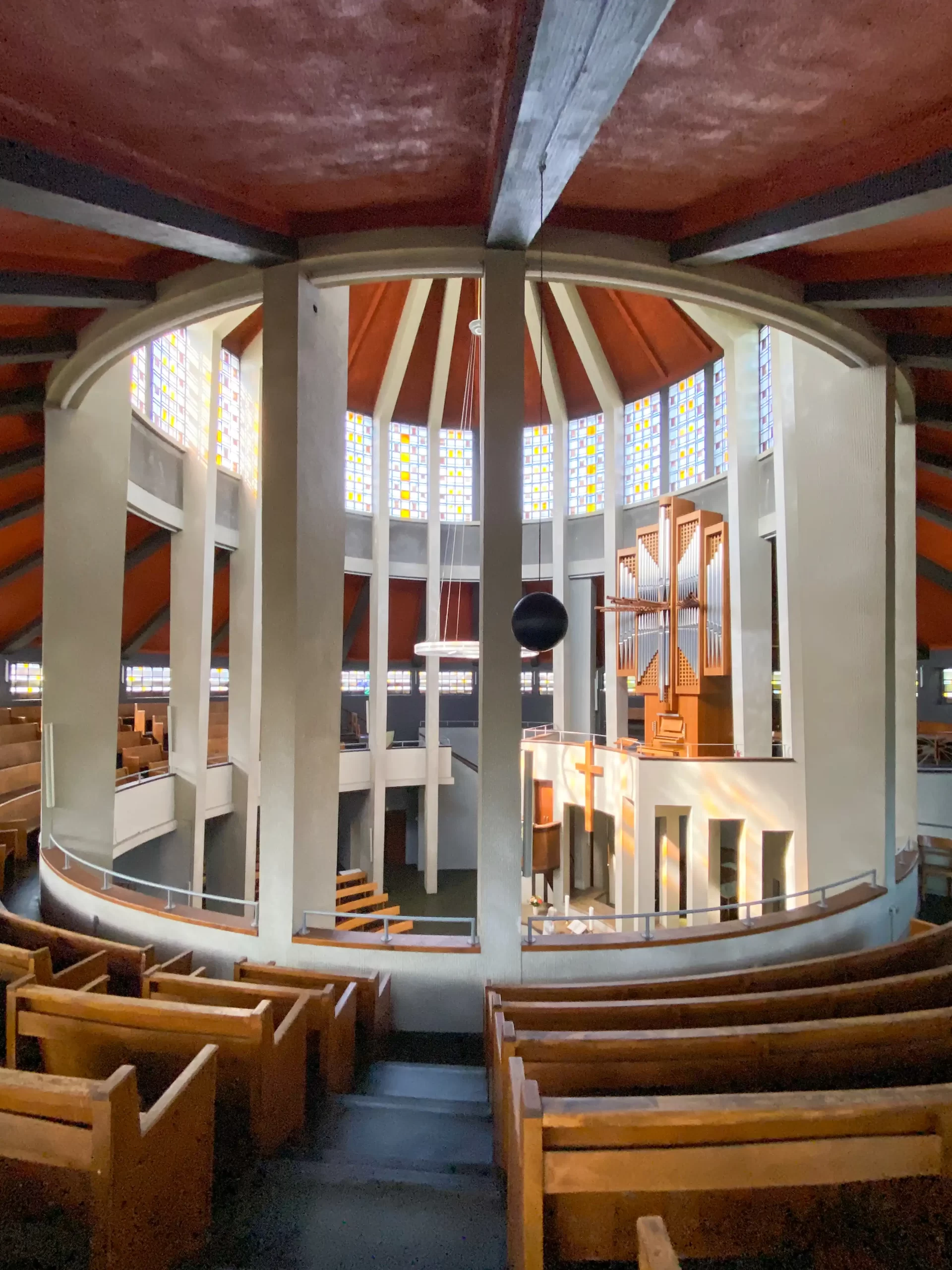
Auferstehungskirche, 1929-1930. Architect: Otto Bartning. Photo: Daniela Christmann
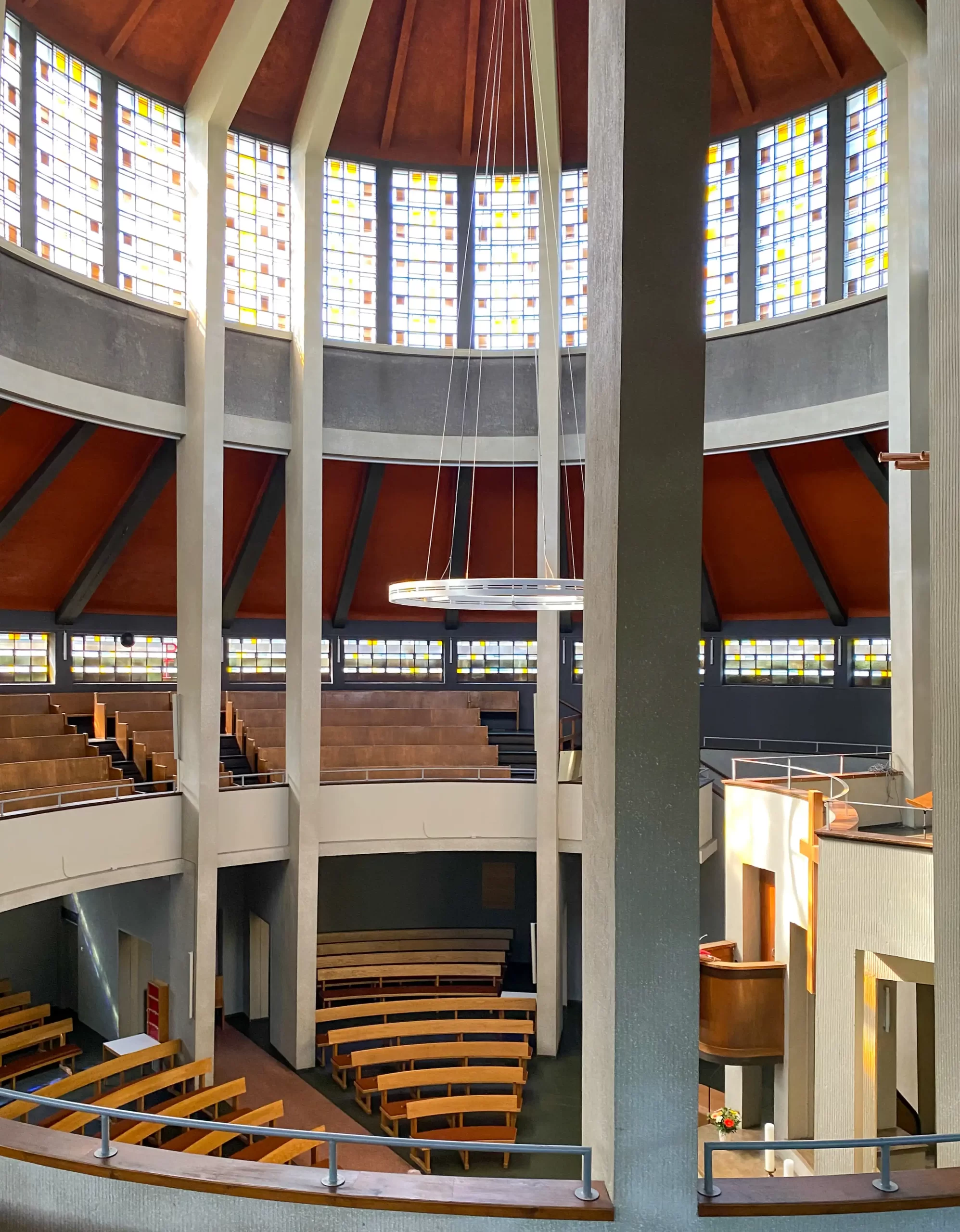
Auferstehungskirche, 1929-1930. Architect: Otto Bartning. Photo: Daniela Christmann
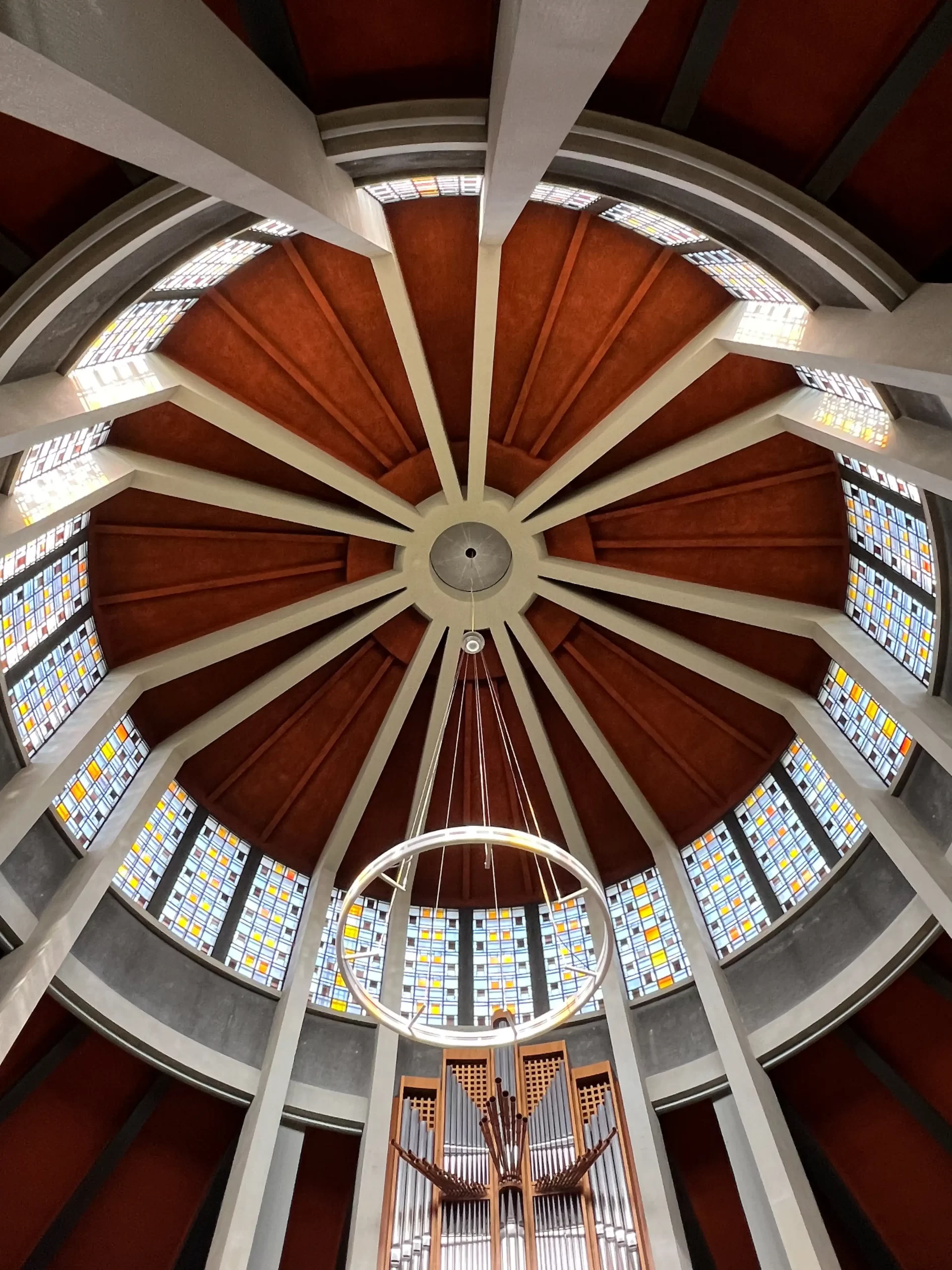
Auferstehungskirche, 1929-1930. Architect: Otto Bartning. Photo: Daniela Christmann
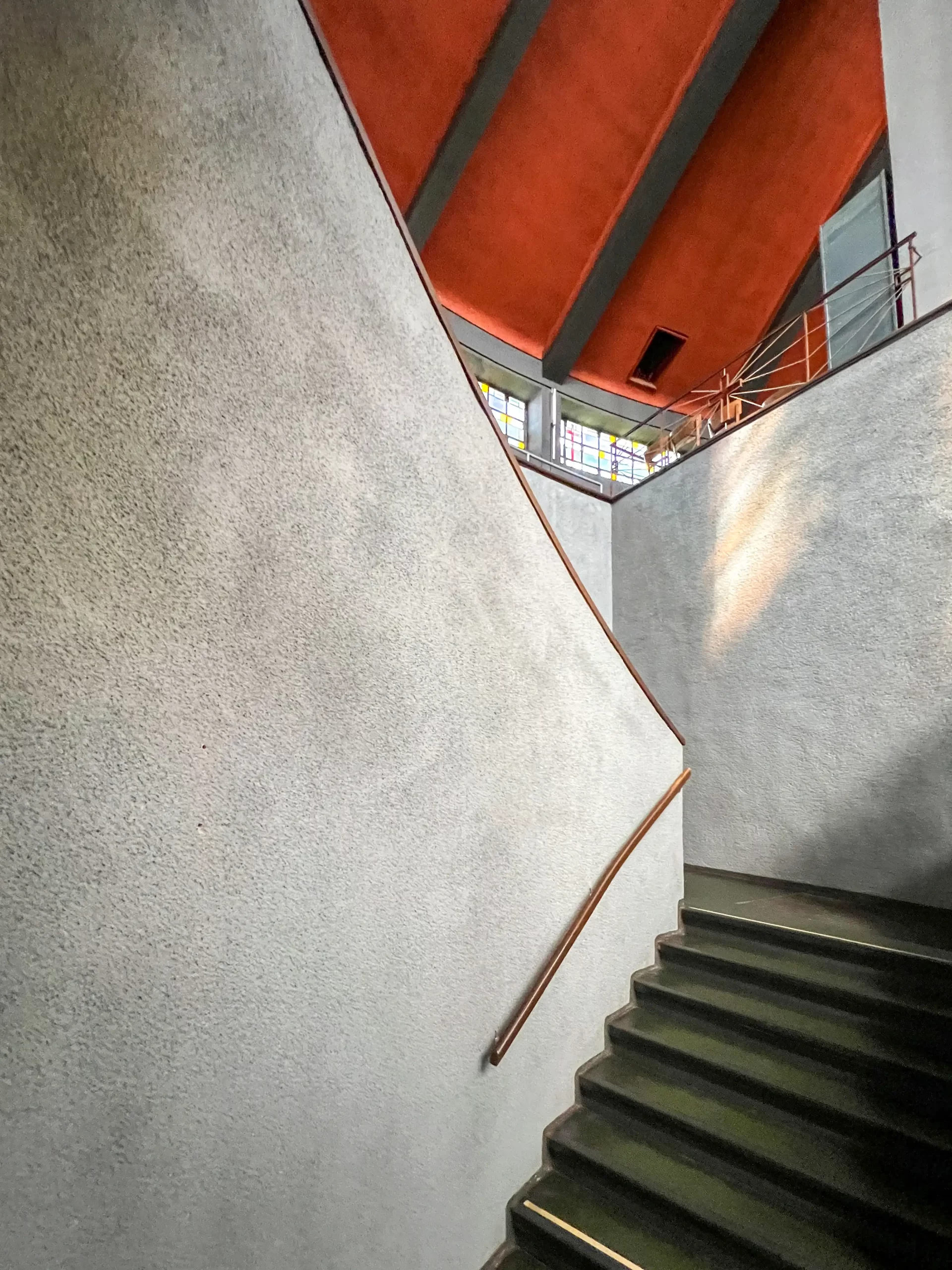
Auferstehungskirche, 1929-1930. Architect: Otto Bartning. Photo: Daniela Christmann
Church Furnishings
The copper baptismal font was designed by the sculptor and goldsmith Hans Wissel.
The stained glass windows were designed by the glass painter Jan Thorn Prikker. They were largely lost during the war and were reconstructed according to the original designs until 2007.
The ceiling surfaces are painted red, the radial ceiling beams are dark. Thin wooden panels rest on the balustrades, further emphasizing the horizontal lines.
The wooden pews follow the arc of the circle, as does the massive altar block, which stands opposite them in the spatial experience, but takes up the lines and stands on the same level without any difference in rank.
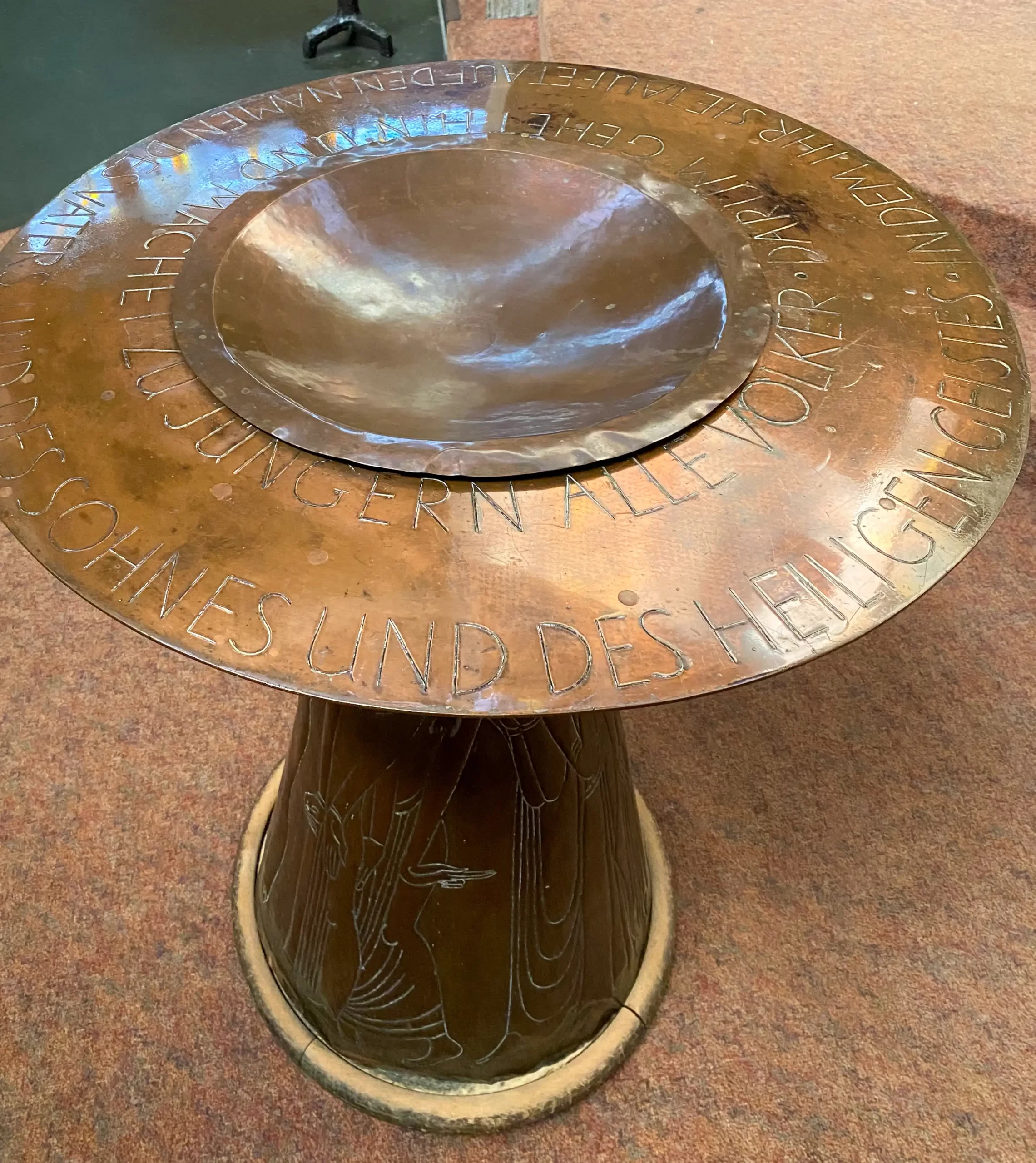
Auferstehungskirche, 1929-1930. Architect: Otto Bartning. Photo: Daniela Christmann
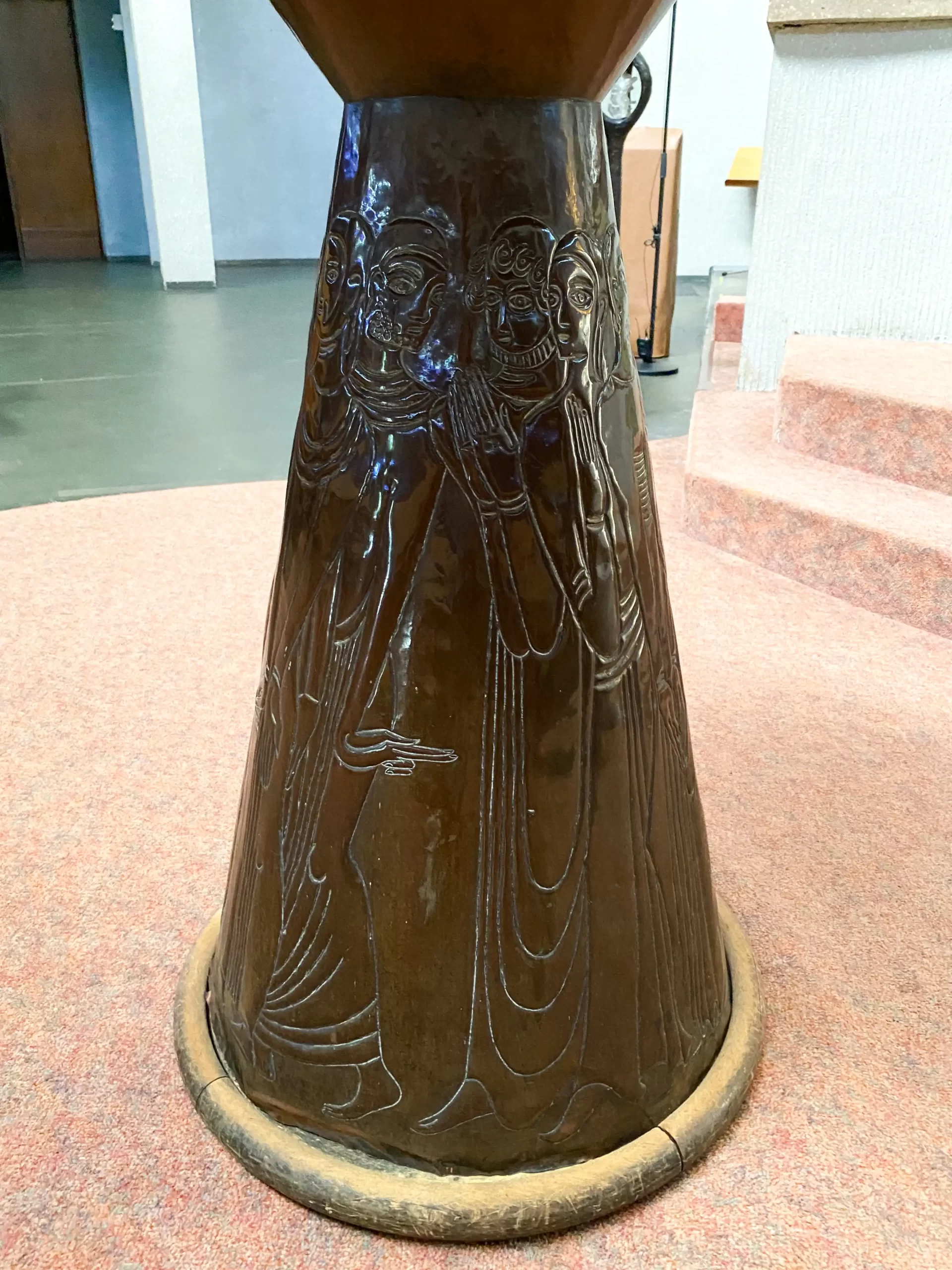
Auferstehungskirche, 1929-1930. Architect: Otto Bartning. Photo: Daniela Christmann
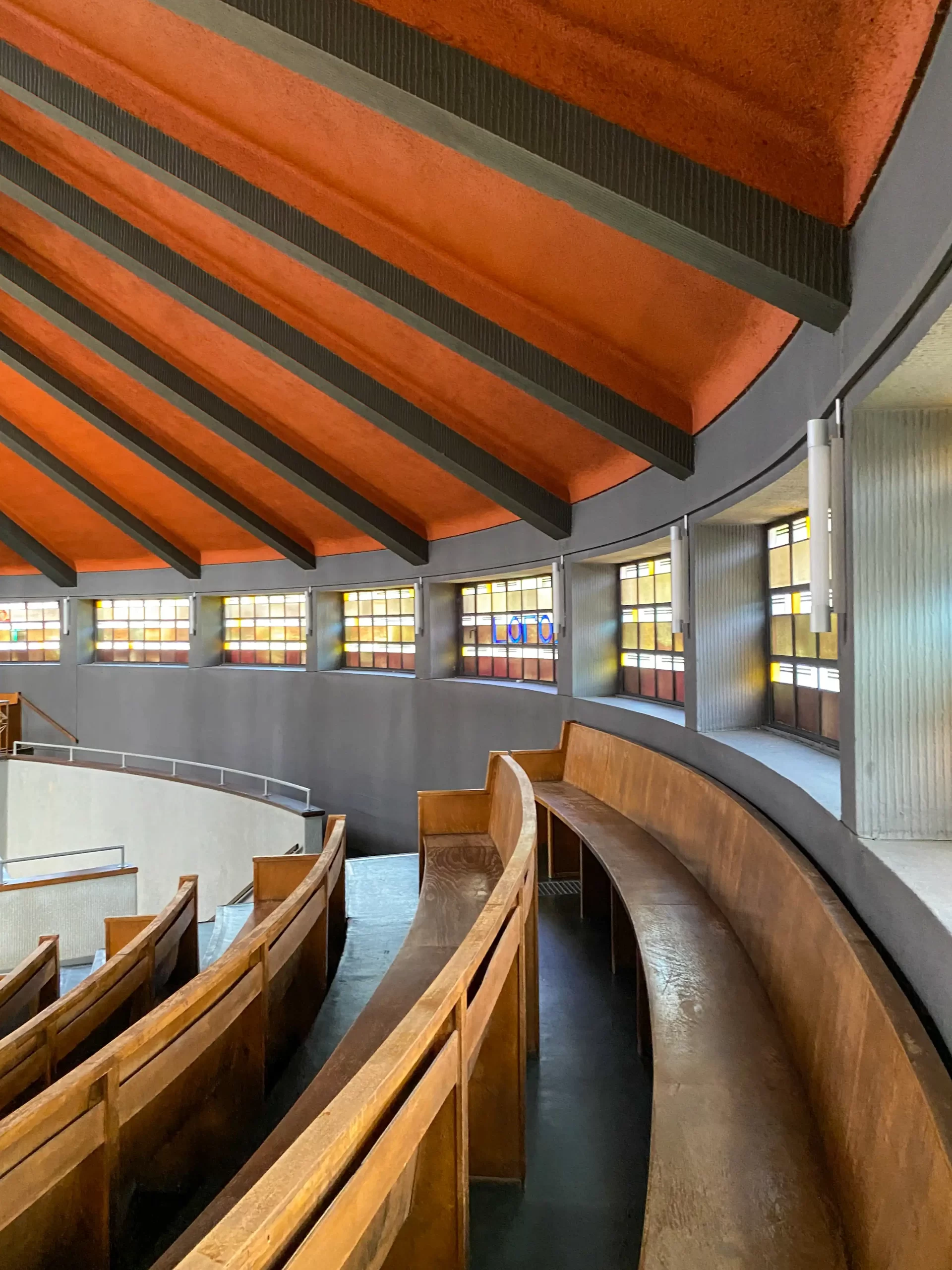
Auferstehungskirche, 1929-1930. Architect: Otto Bartning. Photo: Daniela Christmann
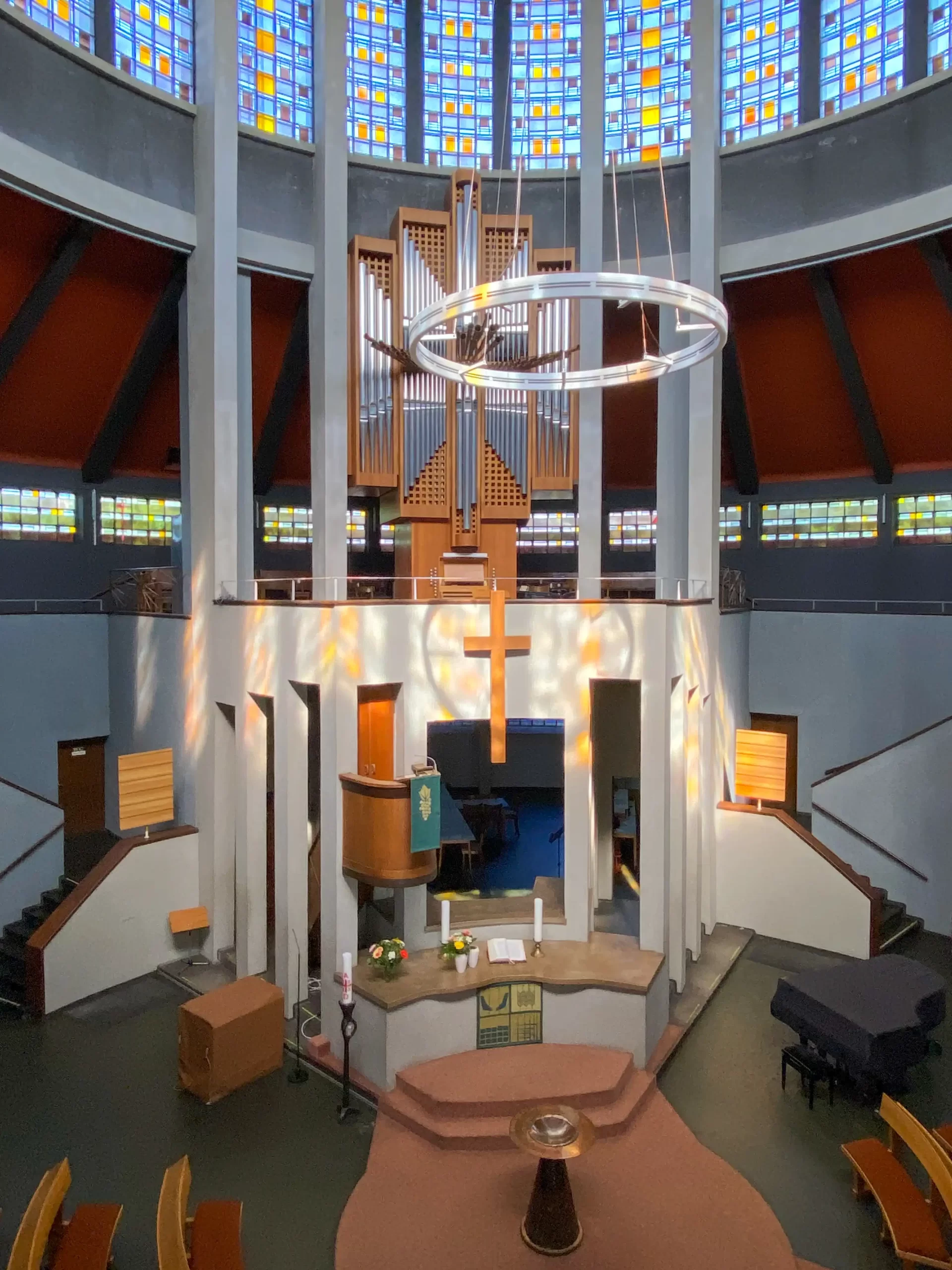
Auferstehungskirche, 1929-1930. Architect: Otto Bartning. Photo: Daniela Christmann
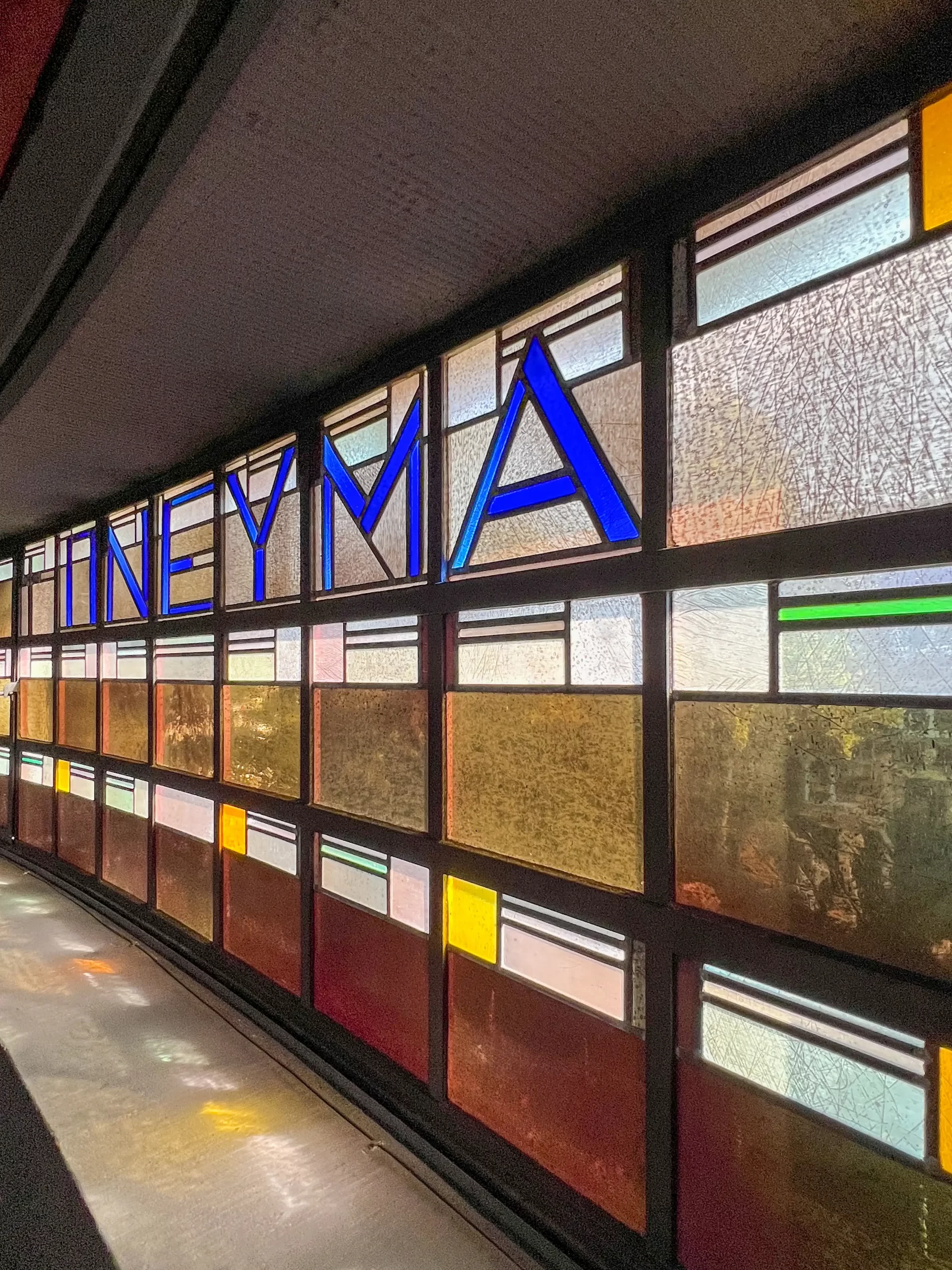
Auferstehungskirche, 1929-1930. Architect: Otto Bartning. Photo: Daniela Christmann
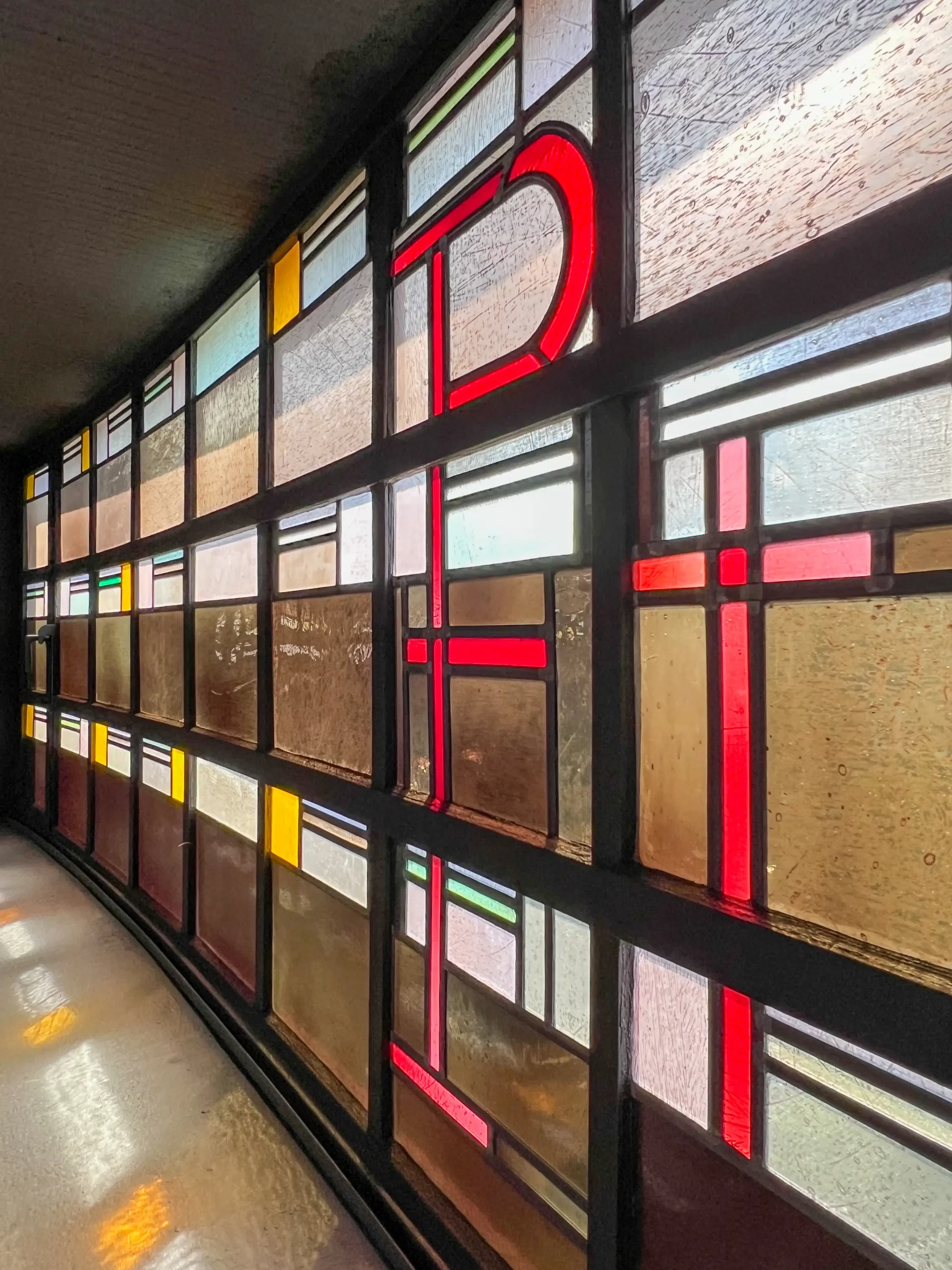
Auferstehungskirche, 1929-1930. Architect: Otto Bartning. Photo: Daniela Christmann
The Organ
The organ above the pulpit is the third one in this place. It was built in 1987 by Karl Schuke’s workshop in Berlin.
Stained Glass Windows
From the very beginning, the stained glass windows designed by the glass painter Johan Thorn Prikker were the main artistic element of the church. They showed geometric patterns into which Christian motifs were inserted.
The original glazing of the three rings of windows, which cover an area of about 170 square meters, as well as in the adjoining rooms – the bridal aisle, the sacristy, the sexton’s room and the toilets – a creation of the modern glass painter Johan Thorn Prikker, was destroyed during the war, along with parts of the church.
It was reconstructed between 1999 and 2007 by the Hein Derix glass workshop in Kevelaer, using the original cartons.
The gray, which lightens toward the top and is interspersed with Christian symbols and primitive words in the central ring, flows into a golden-yellow embossed surface. The way the light and the view are directed symbolically reflects the resurrection event that gave the church its name.
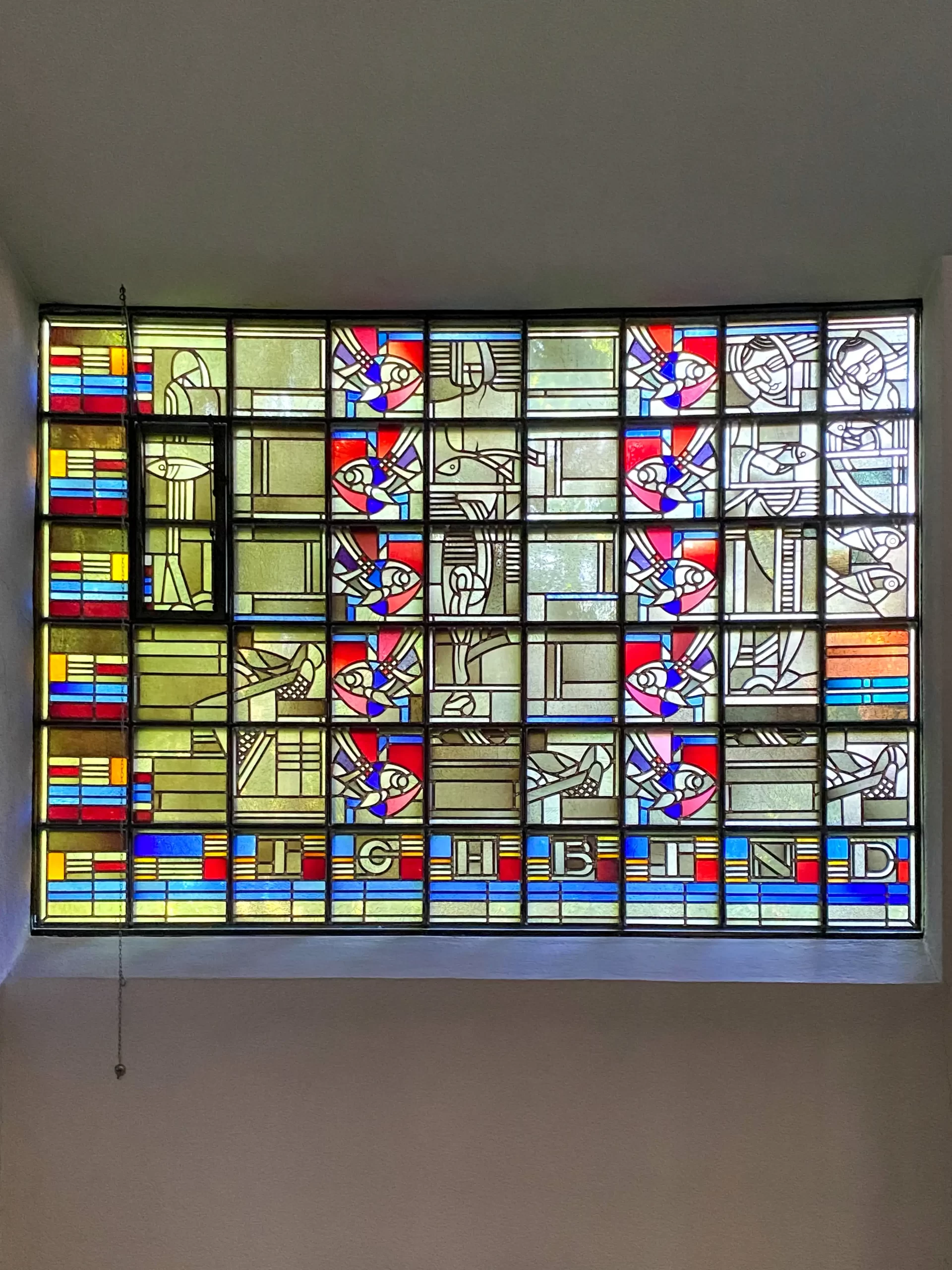
Auferstehungskirche, 1929-1930. Architect: Otto Bartning. Photo: Daniela Christmann
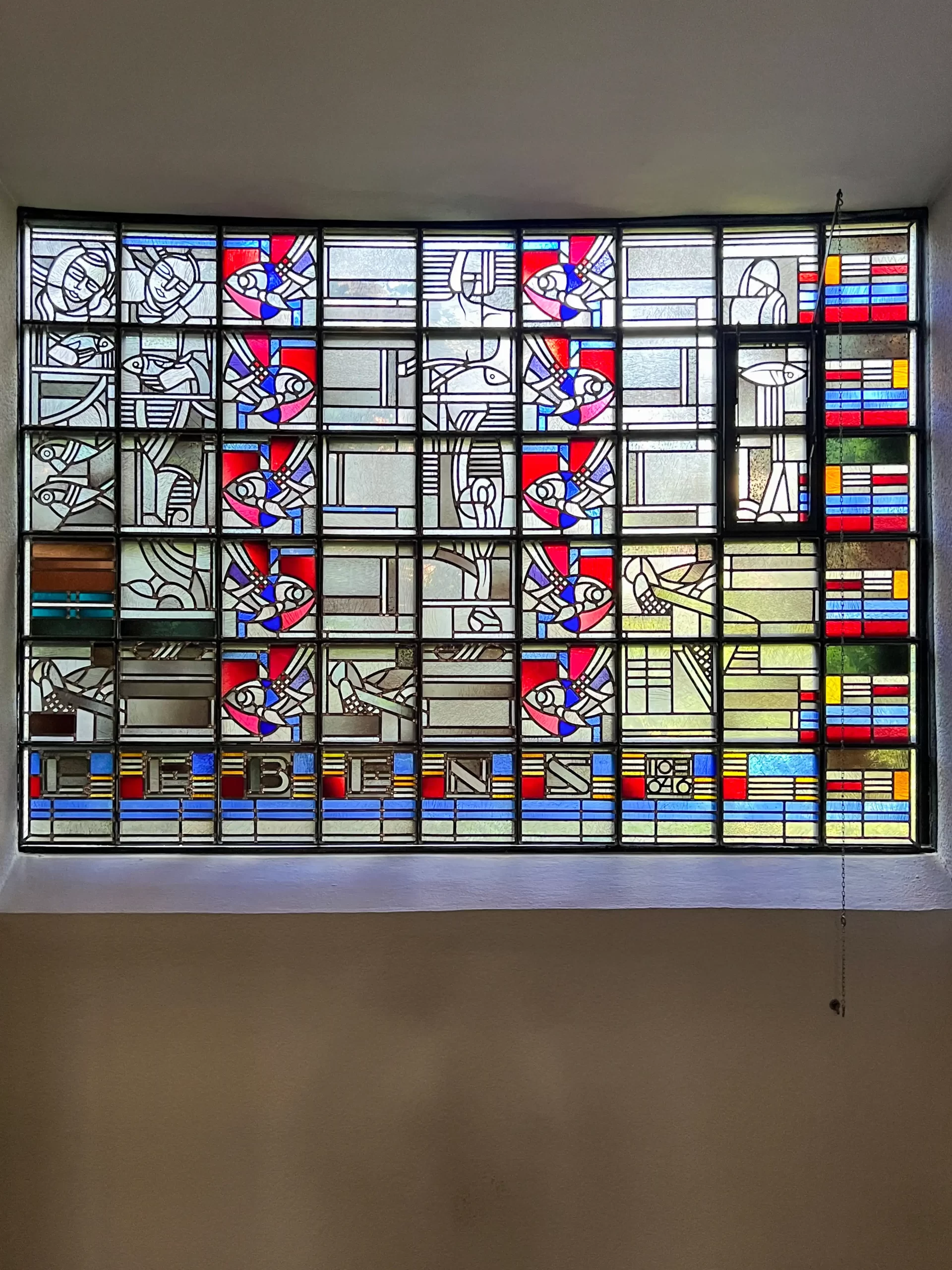
Auferstehungskirche, 1929-1930. Architect: Otto Bartning. Photo: Daniela Christmann
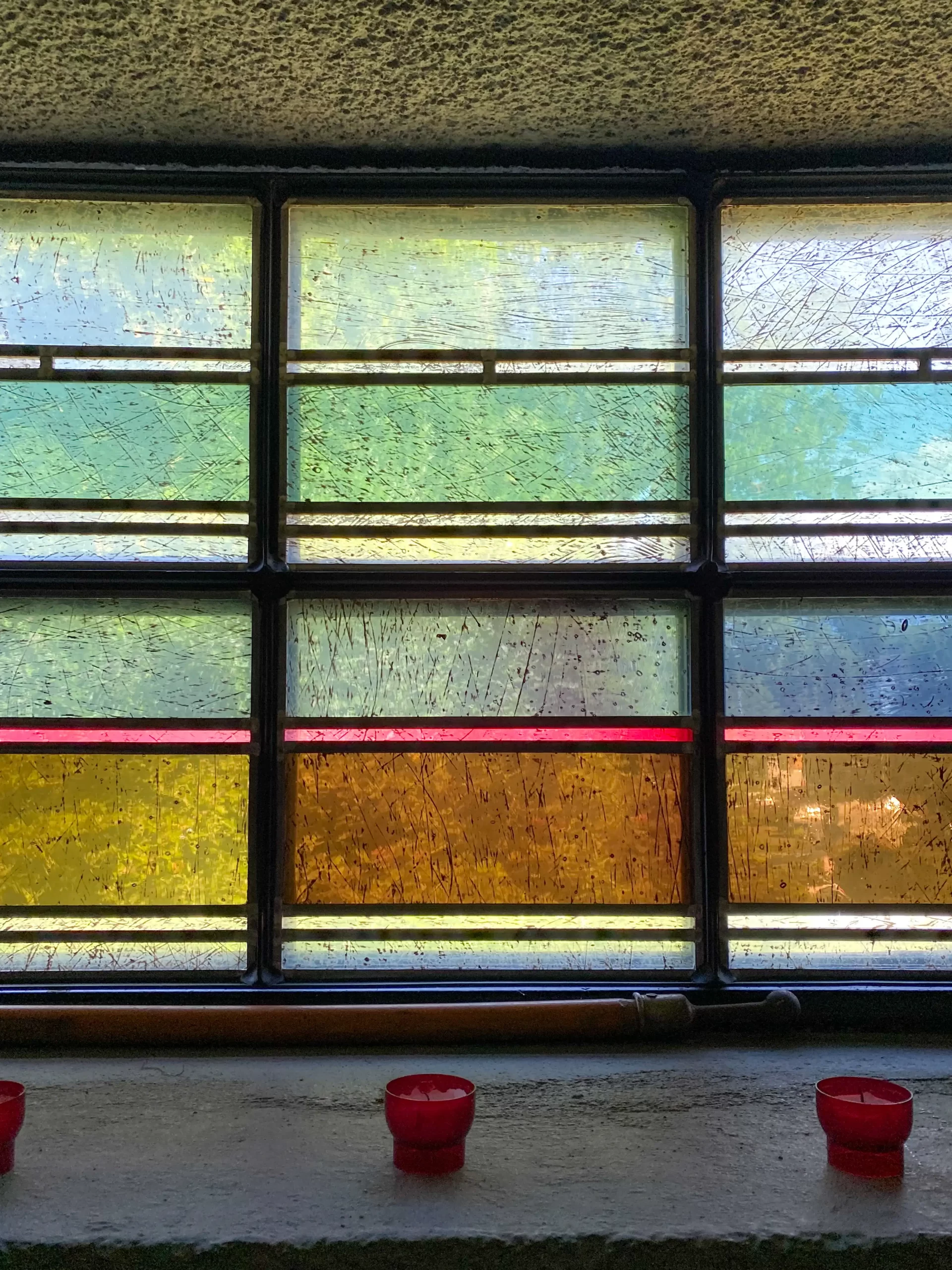
Auferstehungskirche, 1929-1930. Architect: Otto Bartning. Photo: Daniela Christmann
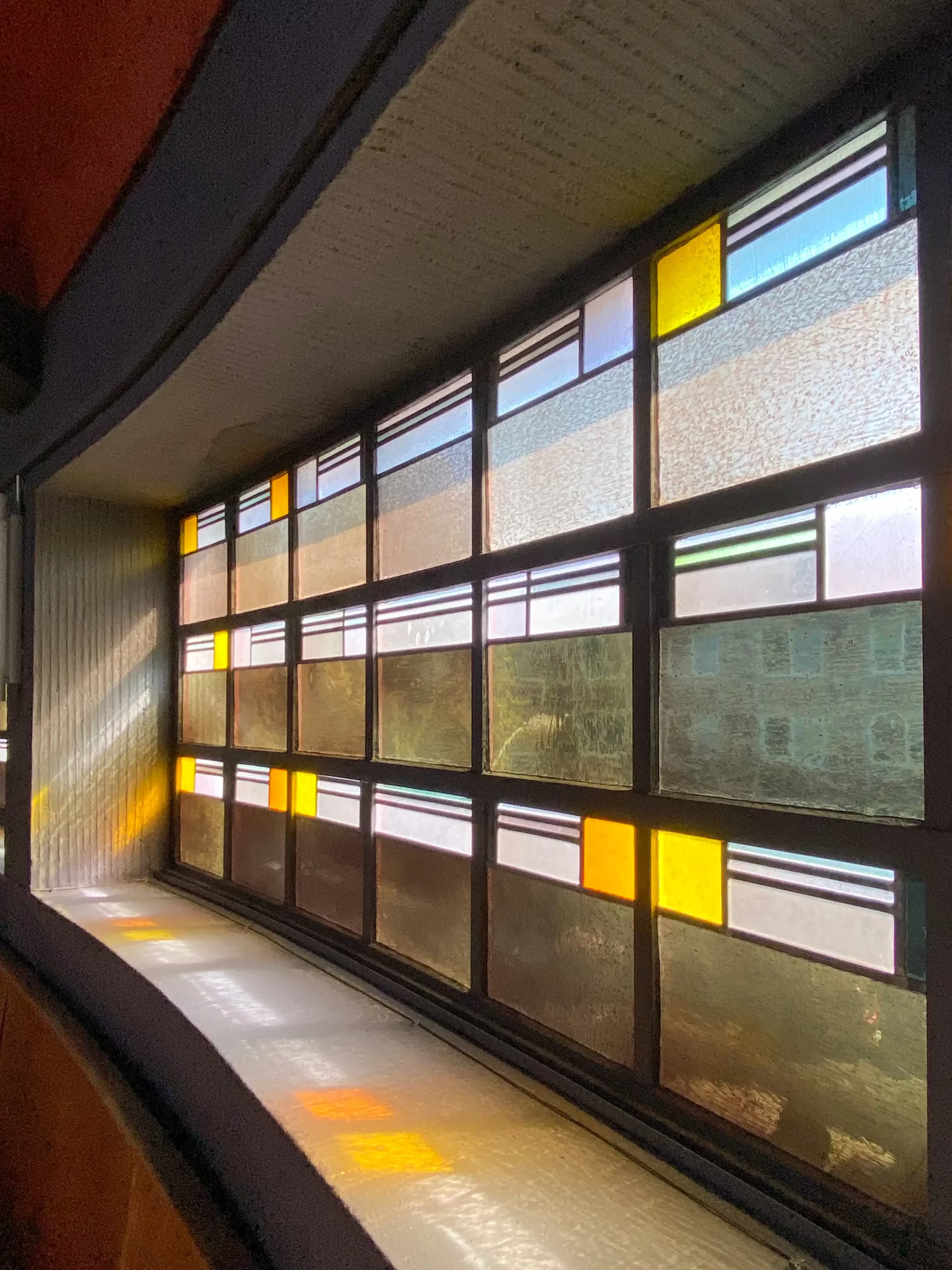
Auferstehungskirche, 1929-1930. Architect: Otto Bartning. Photo: Daniela Christmann
Destruction and Reconstruction
The building was severely damaged and partially destroyed during World War II. It was rebuilt in a simplified form in 1948.
The church was thoroughly renovated in the 1980s. On February 14, 1985, it was listed as a historical monument by the city of Essen.
The church was restored again between 2013 and 2014. First, the copper cross and the copper roof were restored. The most important work was done on the façade, where stones had already flaked off on the west side, which was exposed to the weather.
The old reinforced concrete had become brittle, allowing water to penetrate and damage the steel. In the basement, rooms filled with debris had to be cleared and more water damage was discovered. The thirty-foot bell tower was also in need of repair.
During the recent restoration, the glazing design and lighting concept in particular were restored to their original condition.

